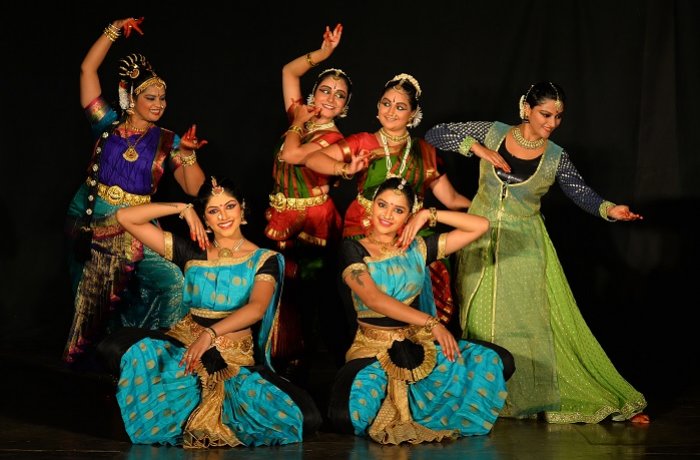
|   |

|   |
Dancing into the hearts of the audience - by Chittaranjan Mothikane e-mail: chittaranjanmothikhane@gmail.com May 27, 2018 Neither the sweltering summer heat of the day nor the threat of a downpour towards the evening deter Mysore rasikas from keeping their date with the Articulate festival. By the fact that there are repeat audience it could be inferred that every third Sunday of the month classical dance presentation has become a monthly ritual for many and on the 20th of May 2018 was the 24th in its series. As usual four segments were lined up for the evening that saw two duet presentations in Bharatanatyam, solo artists in Kathak and Kuchipudi. Shwetha K Purohit and Sindhu K Purohit, disciples of Guru Radha Sridhar, presented two dance numbers from their Bharatanatyam repertoire, one a krithi of Sri Duraiswami Aiyyer and another of Udumalaipettai Narayana Kavi. The chosen first was on Shiva and the second was in praise of Lord Vishnu. In the composition “Aadenamma,” ecstatic Parvathi describes the mystifying looks of Shiva and his dance and savors the nine rasas that awaken in her, as she is enraptured by the smiles of her lord, the killer of Tripurasura. The mother joins her divine consort in that blissful dance. The second composition “Paarkadal” is from the perspective of a devotee of Vishnu. The lord reclining on the serpent, attended by Laxmi herself and floating on the waves of the ocean of milk, is sought for protection and grant of wisdom and means to reach his lotus feet. In the delineation of the poem the dancer runs through the select ten avatars of Lord Vishnu. Shwetha and Sindhu danced into the hearts of the audience through their crisp, clear and confident performance both individually and as duet, complementing each other in every dance stance.  Akhila Deepak, trained under Guru Lakshmi Rajamani, chose to present a Krishna Shabdam and a tarangam, both based in Mohana raga and adi tala. Krishna Shabdam was dominated by abhinaya that was sassy, tarangam was acrobatic nritta. Akhila Deepak reflected so perfectly the unabashed invitations a gopi was extending to Krishna for an amorous rendezvous interspersed with nritta that complimented the sahithya. In the second number of her Kuchipudi presentation, while perched on the rim of a brass plate, balancing a water pot on her head, dexterously making rhythmic movements, she esoterically conveyed the philosophical significance that we are all bound to this earth (the brass plate under the feet) and we carry heavy responsibilities on our head (signified by the water pot, from which not a drop is supposed to spill). But just as she moves joyously in rhythm, her mind in glorious contemplation of god, she says, so too should life be lived, with grace, energy and good purpose. Akhila was impressive. Amitha Mathur trained in Kathak under Nirupama Rajendra and furthered her art under various stalwarts of the art form, began with a Krishna Vandana in Teen Taal that meandered languorously between vilambit laya and drut laya in a highly stylized Kathak. In the vandana, Amitha described the beautiful form of Krishna and demonstrated his leelas so subtle that the vision was dreamy and ethereal. The second item of her presentation was "Rasa" celebrating Kathak while exploring the space to the music; the dancer claimed this was Kathak in its inert form, but with different treatment. This claim was justified by the applause she received after every freeze she made as conclusions to her mercurial twists and turns. Her Teen Taal Tarana in raag Yaman was very short but crisp. Amitha Mathur has been bestowed with all that is necessary for an artist to capture the attention of the audience. In the period of their training under gurus, incumbent artists pickup all the nuances and technicalities of the art form only to start adding their own flavors and colors when they start serious concerts on their own. Sometimes it could be an insult to the entire parampara and destroy the edifice of that hoary tradition so devotedly built and passed down and on. In Anjali Srikant Iyengar and Neethu Anand's duet Bharatanatyam performance, we see their guru Dr. Sanjay Shantaram's every move that oscillate with lightning speed, between tandav and lasya, being mirrored to perfection that flowed right through the two beautifully choreographed and captivating compositions. While the chosen first eulogized the virility and vibrancy of Lord Shiva, the second meditatively dwelled on the serene and composed Sri Rama. Apart from statuesque poses that the jathis were concluded or connected through, being highly exciting to watch, the enfoldment of stories was equally exhilarating. Be it the fleeting enactment of Shiva's protection of Markandeya when he was fated to be taken away by the lord of death in "Parshwapathe Shambho" or in the Yaman Kalyani raga, adi tala composition "Rama Rama Endu" penned by Dr Sanjay Shantaram himself, the pain Sri Rama endured while in search of Seeta and his interaction with Shabari, Jatayu before he faced Ravana only to vanquish him, the sancharis were executed brilliantly by both the artists. They indeed gave a befitting finale number. Festival director Mysore B Nagaraj announced that he would present senior stalwarts Guru Shama Bhate, Guru Deepak Mazumdar and Ranjana Gauhar in Kathak, Bharatanatyam and Odissi through satvik abhinaya on the 17th of June 2018. The audience fixed a cultural tryst for that date. |